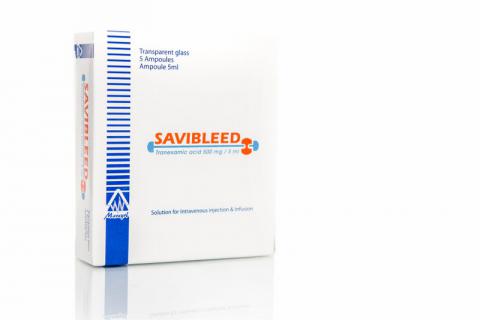Brand Name: Savibleed Ampoules
Active Ingredient: Tranexamic acid 500 mg
When is Savibleed Ampoules prescribed for?
• Local fibrinolysis
For short term use in prophylaxis and treatment in patients at high risk of per - and post-operative haemorrhage is following:
a) Prostatectomy.
b) Conization of the cervix.
c) Surgical procedures and dental extractions in haemophiliacs.
• General fibrinolysis
a) Hemorrhagic complications in association with thrombolytic therapy.
b) Haemorrhage associated with disseminated intravascular coagulation with predominant activation of the fibrinolytic system.
How should you take Savibleed Ampoules?
- Route of administration: by slow intravenous injection.
- Local fibrinolysis: the recommended standard dose is 5-10 ml (500-1000 mg) by slow intravenous injection (1 ml/min), three times daily. If treatment continues for more than three days, consideration should be given to the use of Savibleed tablets. Alternatively, following an initial intravenous injection, subsequent treatment may proceed by intravenous infusion. Following addition to a suitable diluent.
Savibleed may be administered at a rate of 25-50 mg/kg body wt/day. - In children: the dosage is in the region of 20 mg/kg/day. However, data on efficacy, posology and safety for these indications are limited.
Injectable solution: The efficacy, posology and safety of Tranexamic acid in children undergoing cardiac surgery have not been fully established. - Elderly patients: No reduction in dosage is necessary unless there is evidence of renal failure.
- General fibrinolysis:
- In disseminated intravascular coagulation with predominant activation of the fibrinolytic system, usually a single dose of 10 ml (1g) is sufficient to control bleeding.
- Neutralization of thrombolytic therapy; 10 mg/kg body wt by slow intravenous injection.
- In disseminated intravascular coagulation with predominant activation of the fibrinolytic system, usually a single dose of 10 ml (1g) is sufficient to control bleeding.
When you should not take Savibleed Ampoules?
- History of venous or arterial thrombosis.
- History of convulsions.
- Intrathecal and intraventricular injection, intracerebral application (risk of cerebral oedema and convulsions).
Special warning and precautions on using Savibleed Ampoules:
- The indications and method of administration indicated above should be followed strictly:
- Intravenous injections should be given very slowly.
- Tranexamic acid should not be administered by the intramuscular route. - Due to the risk of cerebral oedema and convulsions, intrathecal or intraventricular injection and intracerebral application are contra-indicated. In patients with a history of convulsion, tranexamic acid should not be administered.
- In case of haematuria of renal origin, there is a risk of mechanical anuria due to formation of a ureteral clot.
- In patients with renal insufficiency, because of the risk of accumulation: See the insert leaflet for dose adjustment.
- In massive haematuria from the upper urinary tract (especially in haemophilia) since, in a few cases, ureteric obstruction has been reported.
- In patients with disseminated intravascular coagulation (DIC) treatment must be restricted to those in whom there is predominant activation of the fibrinolytic system with acute severe bleeding.
- The indications and method of administration indicated above should be followed strictly:
- Intravenous injections should be given very slowly.
- Tranexamic acid should not be administered by the intramuscular route. - Due to the risk of cerebral oedema and convulsions, intrathecal or intraventricular injection and intracerebral application are contra-indicated. In patients with a history of convulsion, tranexamic acid should not be administered.
- In case of haematuria of renal origin, there is a risk of mechanical anuria due to formation of a ureteral clot.
- In patients with renal insufficiency, because of the risk of accumulation: See the insert leaflet for dose adjustment.
- In massive haematuria from the upper urinary tract (especially in haemophilia) since, in a few cases, ureteric obstruction has been reported.
- In patients with disseminated intravascular coagulation (DIC) treatment must be restricted to those in whom there is predominant activation of the fibrinolytic system with acute severe bleeding.
Possible Drug interaction with Savibleed Ampoules:
Special information if you are pregnant or breastfeeding
- Pregnancy
Although there is no evidence from animal studies of a teratogenic effect, the usual caution with the use of drugs in pregnancy should be observed. Tranexamic acid crosses the placenta.
- Lactation
Tranexamic acid passes into breast milk to a concentration of approximately one hundredth of the concentration in the maternal blood. An antifibrinolytic effect in the infant is unlikely.
Possible Side effects with Savibleed Ampoules:
Very rare adverse events have been reported.

